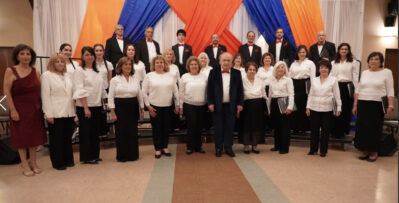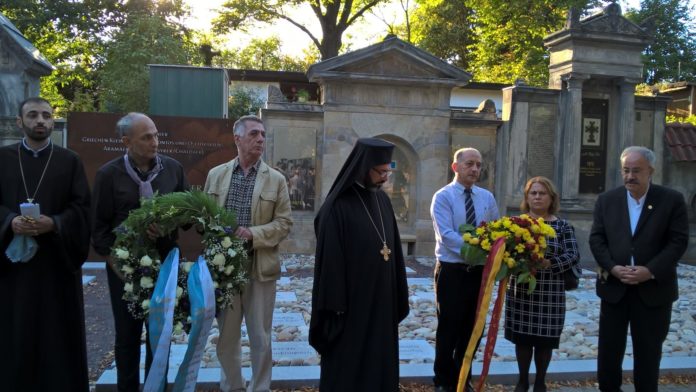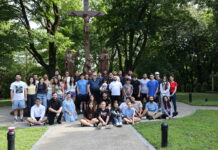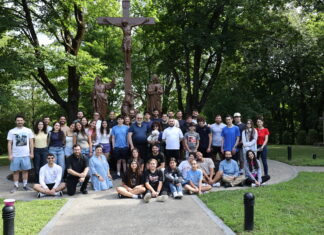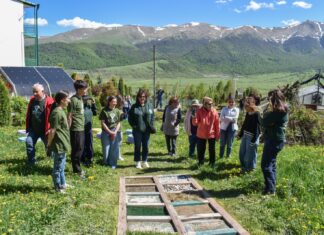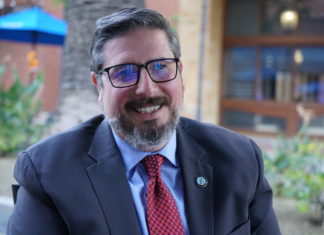BERLIN — At a time when political issues are straining relations among European nations, it is all the more important to reflect on what unites them. In this spirit, the European Commission dedicated the European Year of Cultural Heritage 2018 to the theme of Sharing Heritage. Among the numerous events taking place during this thematic year, under the patronage of German Federal President Frank-Walter Steinmeier, were two initiatives in Berlin earlier this month, linked to the Day of the Open Monument, which commemorated victims of the Ottoman genocide. Dr. Tessa Hofmann, of the Promotional Society for Ecumenical Monuments for Genocide Victims in the Ottoman Empire (FÖGG), organized a tour on September 8 of the Altars of Remembrance which honor the Armenians, the Greeks from Asia Minor, Pontos and Eastern Thrace, as well as the Aramaens, Assyrians and Chaldeans (https://mirrorspectator.com/2018/03/01/ecumenical-altars-remembrance-berlin/). On the following day, she hosted a special day of remembrance for the Greek Orthodox victims of the genocide 1912-1922.
In the presence of diplomatic representatives of the Greek and Armenian embassies, religious leaders of the Greek and Armenian churches, as well as members of the Berlin Greek community, Hofmann recalled that “the concluding chapter of this crime occurred exactly 96 years ago, with the takeover of the undefended Ionian port and capital city Smyrna; there on September 9, units of the so-called liberation armed forces marched in and four days later, after the wind had shifted to a position advantageous to them, set fire to the Christian quarters of the city, beginning with the Armenian quarter Hajnoz.” The nationalist commander Nurettin then ordered males between 18 and 45 deported inland for forced labor, most of whom perished. The remaining Christians, stripped of their citizenship, had to leave. Nurettin was also responsible for implementing the order on January 21, 1921, for 21,000 Greeks to be deported, as well as for the lynching of Archbishop Chrysostomos Kalafatis in Smyrna, and the liberal intellectual Ali Kemal. Nurettin, whom she classified as a “war criminal,” was not only never prosecuted after Turkey was established in 1923, but occupied a high level military position as well as a seat in parliament. “The example shows,” she said, “that the new state integrated war criminals and genocidalists without self-critical reflection as long as they maintained loyalty to the new power holders.”
The date of the event almost coincided also with the ethnic cleansing of Christians from Istanbul on September 6-7, 1955, known as Septembriana, when mobs plundered and burned the Greek Orthodox and Armenian neighborhoods, destroying their churches and cemeteries, torturing Greek priests, raping women and mutilating men. Catholic Uniate Georgians were not spared. Hofmann drew the lesson from Septembriana, that even urban, pluralistic societies may be fragile, and religious or ethnic hatred can rapidly lead to violence. With a view to the current situation in Germany, whose status as a country of immigration is being tested by the refugee crisis, she introduced the keynote speaker, Michael Asderis, author of a book on the history of Istanbul as seen through family history.
The Fate of the Undesired Citizens
Michael Asderis spoke about the “Romyi,” the Greeks living in the Ottoman Empire, so-called because they were the successors to the “Romans,” those who lived in the Roman/Byzantine Empire. The surviving Romyi from Constantinople had lost about 25 percent of their community to emigration after the First World War, and faced an uncertain future. At the Lausanne conference in 1922, Ismet Inönü, leader of the Turkish delegation, had declared Romyi and Armenians to be undesired citizens, and would have expelled them if he could have. In the conference it was decided to let those who had resided within the pre-war city remain. These so-called établis were however restricted in their movements; deprived of their elite, most of whom had emigrated, they were traumatized and at the mercy of the new political leadership.
For years they lived in precarious circumstances, from 1932 on they were excluded from employment as musicians, photographers, drivers, waiters, or in the service sector or construction. In 1941-42 they were corralled into the work battalions for non-Turks of draft age and subjected to discriminatory estate taxes on non-Muslims. Then, in the night of September 6/7, 1955, mob violence raged, leading to deaths, rapes, property confiscation and destruction. In 1964, Greek citizens were deprived of their property and expelled, not only the well-to-do, but also the poorer social classes. Asderis quoted a contemporary French historian who described their plight:
